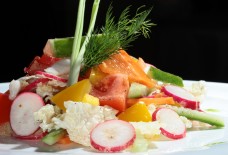The History of Zaatar And a Zaatar Cheesy Delight Recipe
Contributing writer Menal Elmaliki shares what is Zataar, the famous Middle Eastern spice, as well as its history and its importance in the region. Zatar is as popular in the region as ketchup is in America to those who aren’t from the region. What’s special about zatar is the thyme that it is used for, a wild thyme that grows in the Mediterranean and middle eastern region used in their cuisine, spread on bread and eaten with olive oil. Zatar traces back to biblical times and has a reputation being brain food.



